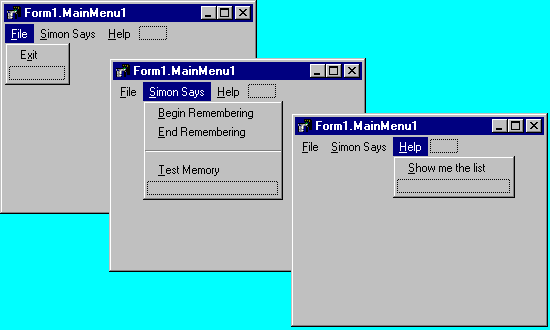    |

|
White Papers -
Articles
|
|
"Creating
Synergistic Components with Delphi"
|
|
James Callan
- KOG Webzine (Page 13)
|
Simon Says
Do you remember the game simon says?
If not, perhaps you can remember the more recent electronic memory game that helps
children remember colors? Using sounds and colors it generates patterns for children
to repeat, thus building hand-eye coordination and memory. We will construct the
first half of a computer-based game that permits the child to play the part of simon.
It, in similar fashion, helps in building memory and learning the colors.
Create a new project and lay out a form according to Figure 10. The form, which you
should save as SIMNSAYS.PAS, contains sixteen TPanels and sixteen TButton controls.
Center each button in its own panel. Set all the panels’ outer bevels to bvLowered.
Then, give each panel a different color from Delphi’s predefined color palette. Make
the upper left panel Black, followed by Maroon, Green, Olive, then continue to the
second row with Navy, Purple, Teal and Gray. Continue coloring the panels down through
White. Name each button based on its corresponding color. Thus, the button over the
Black panel is named and captioned "Black." The button over the Yellow
panel is called "Yellow," etc. |

| Next, drop a TMainMenu and a TMacroRecorder
on the form. Name the macro recorder "Macro1." Then, set up the menu as
shown in Figure 11. |

| Next, add a second form, SHOWCOLR.PAS,
to the project, and center a TMemo control on the second form as shown in Figure
12. |

| Change the memo’s Visible property to
False, its Color property to clActiveCaption, its Font height to 20, and its Font.Color
to clWhite. This helps to color coordinate the memo with the form caption. Finally,
define menu and button click events as indicated in the listings of Figures 13 and
14. Run the new form. |
|
|
|
|
|
|
|
|
|
|
| unit SimnSays; |
| interface |
| uses |
|
Windows, Messages, SysUtils,
Classes, Graphics, Controls, Forms, Dialogs, |
|
StdCtrls, ExtCtrls, Menus,
Macrorec; |
| const |
|
Title = 'Simon Says "Learn
the Colors"'; |
| type |
|
TForm1 = class(TForm) |
|
|
MainMenu1: TMainMenu; |
|
|
File1: TMenuItem; |
|
|
Exit1: TMenuItem; |
|
|
SimonSays1: TMenuItem; |
|
|
BeginRemembering1: TMenuItem; |
|
|
EndRemembering1: TMenuItem; |
|
|
N1: TMenuItem; |
|
|
TestMemory1: TMenuItem; |
|
|
Panel1: TPanel; |
|
|
Black: TButton; |
|
|
Panel2: TPanel; |
|
|
Maroon: TButton; |
|
|
Panel3: TPanel; |
|
|
Green: TButton; |
|
|
Panel4: TPanel; |
|
|
Olive: TButton; |
|
|
Panel5: TPanel; |
|
|
Navy: TButton; |
|
|
Panel6: TPanel; |
|
|
Purple: TButton; |
|
|
Panel7: TPanel; |
|
|
Teal: TButton; |
|
|
Panel8: TPanel; |
|
|
Gray: TButton; |
|
|
Panel9: TPanel; |
|
|
Silver: TButton; |
|
|
Panel10: TPanel; |
|
|
Red: TButton; |
|
|
Panel11: TPanel; |
|
|
Lime: TButton; |
|
|
Panel12: TPanel; |
|
|
Yellow: TButton; |
|
|
Panel13: TPanel; |
|
|
Blue: TButton; |
|
|
Panel14: TPanel; |
|
|
Fuchsia: TButton; |
|
|
Panel15: TPanel; |
|
|
Aqua: TButton; |
|
|
Panel16: TPanel; |
|
|
White: TButton; |
|
|
Help1: TMenuItem; |
|
|
Showmethelist1: TMenuItem; |
|
|
Macro1: TMacroRecorder; |
|
|
procedure BlackClick(Sender: TObject); |
|
|
procedure BeginRemembering1Click(Sender:
TObject); |
|
|
procedure EndRemembering1Click(Sender:
TObject); |
|
|
procedure TestMemory1Click(Sender: TObject); |
|
|
procedure Showmethelist1Click(Sender:
TObject); |
|
|
procedure Exit1Click(Sender: TObject); |
|
private |
|
|
{ Private declarations
} |
|
public |
|
|
{ Public declarations
} |
|
end; |
| var |
|
Form1: TForm1; |
| implementation |
| {$R *.DFM} |
| Uses ShowColr; |
| procedure TForm1.BlackClick(Sender: TObject); |
| begin |
|
Form2.Color := TPanel(TControl(Sender).Parent).Color; |
|
Form2.Left := Left; |
|
Form2.Top := Top; |
|
Form2.Width := Width; |
|
Form2.Height := Height; |
|
Form2.Caption := TButton(Sender).Name; |
|
Form2.ShowModal; |
| end; |
| procedure TForm1.BeginRemembering1Click(Sender:
TObject); |
| begin |
|
Caption := Title+' - (Remembering)'; |
|
Macro1.BeginMacro |
| end; |
| procedure TForm1.EndRemembering1Click(Sender:
TObject); |
| begin |
|
Caption := Title; |
|
Macro1.EndMacro |
| end; |
| procedure TForm1.TestMemory1Click(Sender:
TObject); |
| begin |
|
Macro1.Playback |
| end; |
| procedure TForm1.Showmethelist1Click(Sender:
TObject); |
| begin |
|
Form2.Caption := 'Colors
in order of appearance'; |
|
Form2.Color := clBtnFace; |
|
Form2.Memo1.Text := Macro1.Macro; |
|
Form2.Memo1.Visible :=
True; |
|
Form2.ShowModal; |
|
Form2.Memo1.Visible :=
False; |
| end; |
| procedure TForm1.Exit1Click(Sender: TObject); |
| begin |
|
Close; |
| end; |
| end. |
|
Figure
13
|
| Like the first example, you can turn
remembering "on" and "off" and can click a few buttons to create
a macro. Use the Help menu to display the remembered macros, and choose "Test
Memory" to try your skill at remembering which color will appear next. The game
could be easily extended to randomly create macro patterns by making the Macro property
of TMacroRecorder writable. As is however, the application does exhibit some nice
complexity, made simple through the link associations between our TButton and TCheckBox
components and our TMacroRecorder. |
 

|